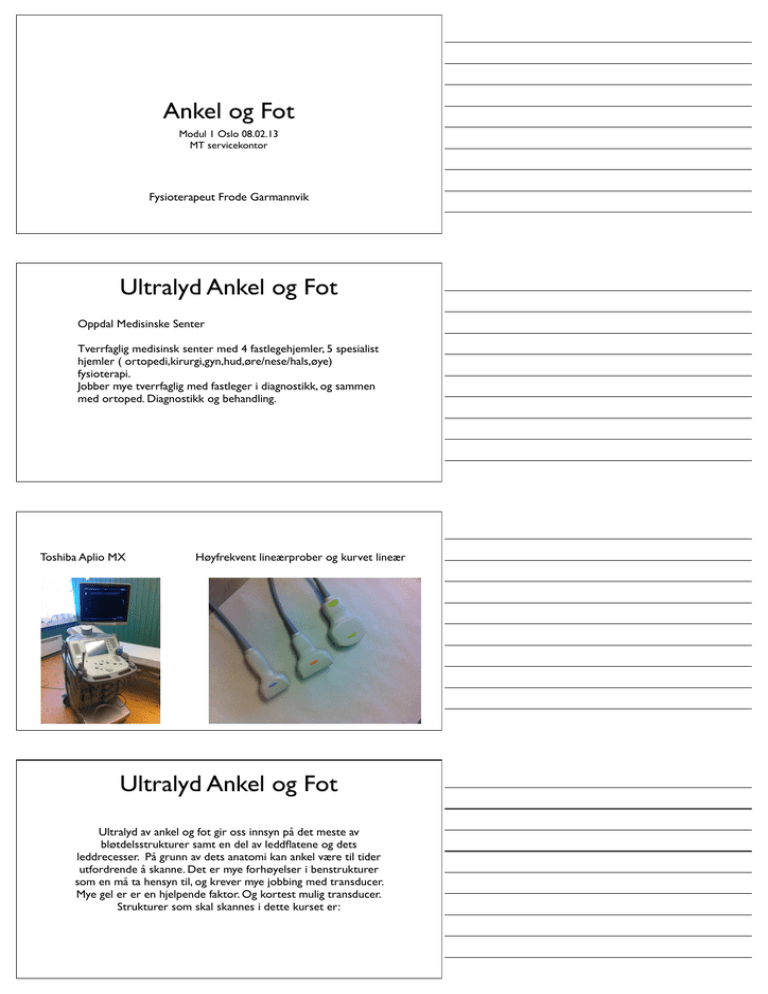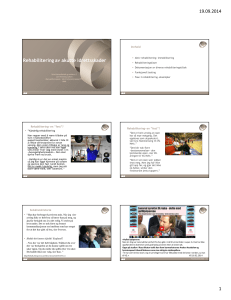Ankel og fot - Manuellterapi
advertisement

Ankel og Fot Modul 1 Oslo 08.02.13 MT servicekontor Fysioterapeut Frode Garmannvik Ultralyd Ankel og Fot Oppdal Medisinske Senter Tverrfaglig medisinsk senter med 4 fastlegehjemler, 5 spesialist hjemler ( ortopedi,kirurgi,gyn,hud,øre/nese/hals,øye) fysioterapi. Jobber mye tverrfaglig med fastleger i diagnostikk, og sammen med ortoped. Diagnostikk og behandling. Toshiba Aplio MX Høyfrekvent lineærprober og kurvet lineær Ultralyd Ankel og Fot Ultralyd av ankel og fot gir oss innsyn på det meste av bløtdelsstrukturer samt en del av leddflatene og dets leddrecesser. På grunn av dets anatomi kan ankel være til tider utfordrende å skanne. Det er mye forhøyelser i benstrukturer som en må ta hensyn til, og krever mye jobbing med transducer. Mye gel er er en hjelpende faktor. Og kortest mulig transducer. Strukturer som skal skannes i dette kurset er: Læringsmål • Lære standardprojeksjoner med ultralyd for Ankel/fot • Lære de anatomiske strukturer som skannes med ultralyd • Bli kjent med hvordan de forskjellige vevstyper og anatomiske strukturer fremstår med ultralyd • Lære fallgruber og anatomiske varianter som kan feiltolkes som patologi Strukturer og anatomi Lateralt Peroneus sener - Peroneus Brevis til insersjon - Peroneus Long til den dukker under Plantae - «brevis nær bein» Pb muskel Pb sene Strukturer og anatomi Ligamentstrukturer • Lig Talofib Ant • Lig Calcaneofibulare • Lig Tibfib (syndesmose) Tips: Mot 2 tå Anteriort • Extensor Digitorum • Extensor Hall Longus • Tibialis Anterior Ext Dig Ext Hall Tib Ant Long FlexTib Flex Hall post Dig Long Flex Art,Ven,Nerv Tib Flexdigitorum Post Hall Long DEL 2 Posterior Akillessene • Entese • Midtporsjon • Muskel/seneovergang ‘ Flex Hall Long Kaegers M.Soleus fettpute akillessene M.Gastrocnemius M.Soleus Plantarasene Medial beliggenhet, også medial og lateral del Vanskelig å skanne, da hælpute absorberer mye signal. Øke gain og pass på fokuspunkter. Hyppigst patologi i feste, har entese. Normalstr 0,3-0,5 cm tykk Fallgruber og anatomiske varianter • Anisotrofi Ultralydbølger som ikke treffer 90 gr på en struktur vil en kunne se som hypoekkoisk (spes sener,ligamenter) og mistolke som patologi Fallgruber og anatomiske varianter • Dynamisk UL undersøkelse En av fordelene med UL er den dynamiske undersøkelsen, å unnlate å bruke denne minsker verdien UL. Alltid bruke dynamisk US. Fallgruber og anatomiske varianter • Fysiologisk væske I seneskjeder og ledd kan en alltid forvente en viss grad av væske. Dette er fysiologisk. Derfor må en alltid inkludere den kliniske undersøkelsen og skanne samme struktur motsatt side. Spesiellt gjelder dette: • Peroneussener • Ext digitorum • Tib Post Ultralyd Ankel og Fot Internasjonal konsensus på verdien av UL i diagnostikk av ankel og fot. Underbruk av UL som billeddiagnostikk i Norge. 1.Ultrasound of the ankle and foot. Rawool NM, Nazarian LN. Source Department of Radiology, Thomas Jefferson University Hospital, Philadelphia, PA 19107, USA. Nandkumar.Rawool@mail.tju.edu Ultrasound is an excellent tool for evaluating common ankle problems. it is more economical than MRI and its real-time nature helps in correlating the study with the symptomatic area. US can be used in ankle to evaluate tendons (including tears, tendinitis and tenosynovitis), joints, plantar fascia, ligaments, soft tissue masses, ganglion cysts, Morton's neuroma, and to look for foreign bodies. Power Doppler can be used to evaluate blood flow in acute inflammatory process and in reflex sympathetic dystrophy. 2.Ultrasound of ankle and foot: overuse and sports injuries. Khoury V, Guillin R, Dhanju J, Cardinal E. Source Department of Radiology, Hôpital Notre-Dame, Centre Hospitalier de l'Université de Montréal, Montreal, Quebec, Canada. viviane.khoury@umontreal.ca Sports and overuse injuries of the ankle and foot are commonly encountered in clinical practice. Ultrasound (US) has been established as an excellent diagnostic modality for foot and ankle injuries, providing a rapid noninvasive, economical, and readily available tool that is well tolerated by the patient with acute or chronic pain. The opportunity for dynamic examination is another advantage of US in evaluating ankle and foot pathology, where maneuvers such as muscle contraction and stressing of the joint may be particularly helpful. In many cases, US can be used as a first-line and only imaging modality for diagnosis. This article focuses on ankle disorders related to sports or overuse that affect tendons, including tendinosis, tenosynovitis, paratendinitis, rupture, dislocation, and ligaments that are commonly torn. The sonographic features of certain common foot disorders related to physical activity and overuse are also discussed, including plantar fasciitis, Morton's neuroma, stress fractures, and plantar plate injury. Ultralyd Ankel og Fot Internasjonal konsensus på verdien av UL i diagnostikk av ankel og fot. Underbruk av UL som billeddiagnostikk i Norge. Ultrasound of the ankle. Morvan G, Busson J, Wybier M, Mathieu P. Source Cabinet d'imagerie de l'appareil moteur, 5 rue Alfred Bruneau, 75016 Paris, France. Because of their size and superficial location the ankle tendons can be well evaluated with ultrasound (US). The excellent definition of the modern high frequency probes allows us to consider US the technique of first choice in their assessment. Basic US appearances correlate well with the MRI findings. Since US can diagnose most tendon disorders including tendinopathies, tears, dislocations and enthesopathies MRI is less often utilized. US can easily depict the main ankle ligaments. The basic US appearance of ligament tears is well known. US can be considered an inexpensive and accurate technique in the evaluation of ankle sprains. PMID: 11567856 [PubMed - indexed for MEDLINE] Ultrasound of peroneal tendons. Bianchi S, Delmi M, Molini L. Source CIM Cabinet Imagerie Medicale, Genève-CH, Switzerland. stefanobianchi@bluewin.ch Disorders of the peroneal tendon (PeT) complex are common and affect patients of many different ages. They can be traumatic, inflammatory, infective, or degenerative. Clinical assessment orients the diagnosis, but an imaging modality is almost always performed to confirm the clinical impression and to obtain additional information that is essential in choosing among different treatments. Due to its peculiar characteristics of high resolution, cost effectiveness, noninvasiveness, and dynamism, ultrasound (US) is now widely considered the first-line imaging modality to assess superficial tendons. US not only allows an optimal evaluation of the PeT complex but can also accurately assess its synovial sheath, retinacula, and adjacent tissues. This article describes the normal anatomy, technique of examination, and normal US anatomy of the PeT complex as well as illustrating the US appearance of its main disorders. Thieme Medical Publishers. PMID: 20539955 [PubMed - indexed for MEDLINE] Takk for meg
